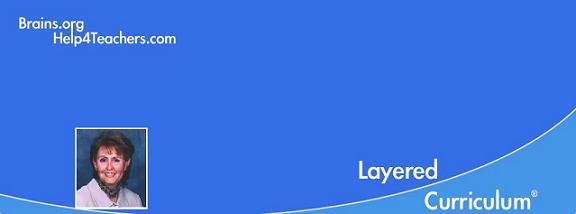__________Layered Curriculum®. . . because every child deserves a special education™_
 |
|
![]() _
_ ![]()
Layered
Curriculum TEXT & WORKBOOK
Set
for only
$43.95
(free shipping in
US)
Tweet
Do these Kids Ever Sleep?By Dr. Kathie F. Nunley
© 2014There's been a lot of buzz lately over the research and data now out on the amount of time our kids spend in front of screens and consuming media. When Larry Rosen released his research showing that young kids today spend over 20 hours a day consuming media, I've heard many people exclaim, Oh my….Don't these kids sleep!? .
It may not be quite as awful as it first appears - though most of us in educational and developmental psychology do have concerns. First though, it's important to distinguish between "screen time" and time spent "consuming media". Media covers a host of entertainment devices, not all of which involve eyes open and looking at a screen. Listening to music or a television or video program running in the background while sleeping is still consuming media. And that's how that number gets so high.
Unfortunately too many of our kids are indeed listening to music, Internet programs, video programs, etc while sleeping. This is not a healthy way to sleep - especially for young brains! You've probably heard that most of the "hard wiring" of the learning process occurs during sleep, and that's correct.
We are exposed to a tremendous amount of information and stimuli during the day - the vast majority of which is not important and does not need to be stored for the long term (for example, the color or type of car that stopped on your left at the traffic light this afternoon). Sleep is when our brain sifts through all that input from the day and determines which needs to be stored, or hardwired in, and which can be discarded. So you remember the important parts of a lecture you heard today, but not so much about the conversation you overhead on your way into the lecture.
Sleep is the time for the brain's chemical maintenance department to really get to work. Chemicals called neurotrophins help hardwire the important learning and make connections from one region of your brain to another. The chemical calpain is involved in ridding the brain of extra neurons that you don't use and are getting in the way of construction. Most of this happens as we sleep. In order for it to occur thoroughly and appropriately, we need dark and quiet while sleeping. Noise, be it music, or video background also are processed by the brain and interrupt the maintenance going on.
So if your child tells you that they simply cannot fall asleep without some type of background music, just make sure there's a timer set on it so after 30 minutes or so, it shuts off.
But all this "media consumption" comes with some positive perks too (at least for daytime consumption!). All these multiple forms of media use may be leading to some superior cognitive processing too, especially among the youngest kids - known as digital natives. These young, digital natives, or Igeneration as they are also sometimes known, grew up with media. They never had to "learn" it like their parents did; it was there from day one. Their ability to handle distractions in their environment while engaged in work and learning and their ability to handle multiple tasks at once is incredible. The American Academy of Pediatrics now suggests that we may see drastic physical differences in brain regions. They conclude that as a result of so much media at a young age, these children have enhanced or improved working memory and other special neurological skills.
Schools and teachers are rushing to keep up with these fast-paced, media-ready brains. They depend more and more on technology to be embedded in the learning experience to allow these brains to pace themselves and learn in diverse ways. Laptops, tablets and smartphones as information delivery systems in the classroom are now more the rule than the exception.
So while we see the youngest generation consuming media with abandonment, we acknowledge the need for adults to help limit it to appropriate place and time and embrace and encourage it for the cognitive benefits it is bringing to our youngest.
References:
American Academyof Pediatrics, news release, Oct 10, 2014.Nunley, K. (2006). A Student's Brain: The parent / teacher manual. Amherst, NH:Brains.org
Rosen, L. (2011). "Poke Me: how Social Networks can both Help and Harm out Kids" presented at the American Psychological Association National Convention, August 6.
About the Author:
Dr Kathie Nunley is an educational psychologist, researcher and author of several books on parenting and teaching, including A Student's Brain (Brains.org) and the best selling, "Differentiating the High School Classroom" (Corwin Press). She is the developer of the Layered Curriculum® method of instruction and has worked with parents and educators around the world to better structure schools to make brain-friendly environments. In addition, her work has been used by the Boeing Corporation, Family Circle Magazine, the Washington Post, and ABC television.
Email her: Kathie (at) brains.orgCopyright © 1998 - current year by Kathie F. Nunley.
All Rights Reserved.
Layered
Curriculum is a registered trademark developed by
Dr. Kathie F. Nunley.